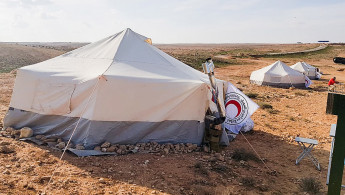More than 7,000 Syrian refugees leave remote camp for regime-controlled territory
More than 7,000 people have left a desperate desert camp for displaced Syrians near the Jordanian border since March, a United Nations spokesperson said Friday.
According to the UN's humanitarian coordination office OCHA, around 36,000 people remained in the isolated Rukban camp near Al-Tanf base used by the US-led coalition fighting the Islamic State group, after over 4,000 left between March and April 21.
The Syrian regime and its key backer, Russia, said in February they had opened humanitarian corridors out of the camp, calling on residents to leave.
"Since March, over 7,300 people have left Rukban," OCHA spokesman David Swanson told Agence France-Presse, including some 3,000 who left after April 21.
Those who have quit the camp have moved to collective shelters in the central city of Homs or resettled in their areas of origin in the province of the same name, OCHA said Thursday.
It said Rukban residents were organising their own transportation to the edge of a de-escalation zone established around Al-Tanf, from where they either continued in their vehicles or were transferred by private or government-provided vehicles to four collective shelters in Homs city.
The Britain-based Syrian Observatory for Human Rights says those returning to government-held parts of Homs from Rukban had struck so-called "reconciliation deals" with the Syrian government.
Conditions inside Rukban are dire, with many refugees surviving on just one simple meal a day, often bread and olive oil or yoghurt, according to one resident.
Previously, Russia threatened to starve the residents of the camp after they refused to leave use the "corridors" it had set up to go to regime-controlled territory.
The camp has been particularly difficult to reach due to its remote location in the desert on the Jordanian border and the proximity of US forces and the rebels they support.
In February, a humanitarian convoy of 133 trucks delivered food, clothes, healthcare items and medical supplies to the camp's residents.
The February 6 delivery was just the second in three months.
Hundreds of thousands of people have been killed and millions more displaced in the Syrian conflict, which broke out following the suppression of peaceful protests by the Assad regime in 2011. Most of the casualties were caused by regime bombardment of civilian areas.





 Follow the Middle East's top stories in English at The New Arab on Google News
Follow the Middle East's top stories in English at The New Arab on Google News
![The UAE is widely suspected of arming the RSF militia [Getty]](/sites/default/files/styles/image_330x185/public/2024-11/GettyImages-472529908.jpg?h=69f2b9d0&itok=Yauw3YTG)
![Netanyahu furiously denounced the ICC [Getty]](/sites/default/files/styles/image_330x185/public/2024-11/GettyImages-2169352575.jpg?h=199d8c1f&itok=-vRiruf5)
![Both Hamas and the Palestinian Authority welcomed the ICC arrest warrants [Getty]](/sites/default/files/styles/image_330x185/public/2024-11/GettyImages-2178351173.jpg?h=199d8c1f&itok=TV858iVg)